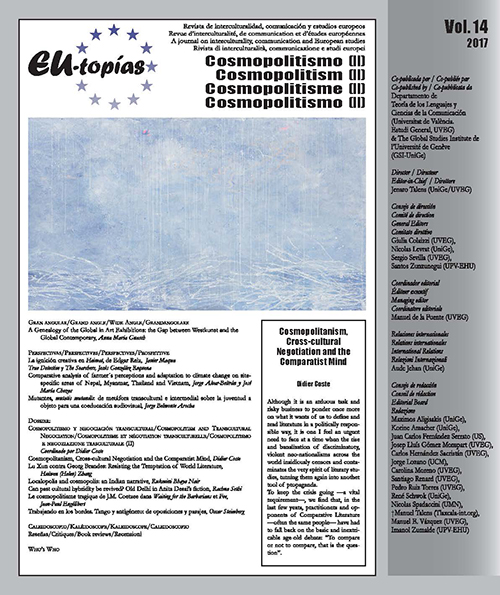Can past cultural hybridity be revived? Old Delhi in Anita Desai’s fiction
DOI:
https://doi.org/10.7203/eutopias.0.18599Keywords:
Anita Desai, Clear Light of Day, In Custody, spatiality, social processes, cultural hibridity Abstract
Abstract
The paper explores the dynamic relationship between spatiality and social processes in the city, the “lived spaces” negotiated by writers/characters/ readers. It focuses on Shahjahanabad/Old Delhi and its grandiose past of rich history, linguistic and poetic traditions with reference to Anita Desai’s novels Clear Light of Day and In Custody, and unravels connections at the intersection of the real and the fictional city. The Mughal city was famed not just for its architectural magnificence but its composite culture and its art connoisseurs. Historical forces destroyed the city physically, dismantled its cultural life and in the process strangled its soul. The two novels repeatedly invoke nostalgia for past grandeur and harmony, and the paper suggests the need to move beyond mourning for lost traditions in the text and outside by reader-citizens, and raises possibilities of cultural hybridity in the transformed spatialities.
 Downloads
Downloads
 References
References
Ahmad, Aijaz (1996) Lineages of the Present: Political Essays. New Delhi: Tulika.
Ali, Ahmed. [1940].Twilight in Delhi. New Delhi: Rupa, 2007.
Arasteh, P, and H. Pirnajmuddi (2014). “The Mimic (Wo)man ‘Writes Back’: Anita Desai’s In Custody”. International Letters of Social and Humanistic Sciences 16 (1) () 57-66. Retrieved from www.ilshs.pl on November 30, 2016
Barthes, Roland (1997). “Semiology and the Urban.” N. Leach(ed.) Rethinking Architecture: A Reader in Cultural Theory. London and New York: Routledge. 166-72.
Benjamin, Walter (1986). “A Berlin Chronicle.” in P. Demetz (Ed.) Reflections: Essays, Aphorisms, Autobiographical Writings. New York: Schocken. 3-60.
Bruschi, Isabella (2001). Partition in Fiction: Gendered Perspectives. New Delhi: Atlantic Publishers.
De Certeau, Michel (1984). The Practice of Everyday Life. Berkeley, CA: University of California Press.
Desai, Anita (1980). Clear Light of Day. New Delhi: Penguin.
— (1984) In Custody. New Delhi: Random House, 2008.
Foucault, Michel (1986). “Of other spaces” Diacritics 16/1 (): 22- 27.
Gee, M. (2004). “Anita Desai in conversation with Maggie Gee.” Wasafiri, 19.42 () 7-11. 7.
Guignery V. and T. Alexis (2009). “In Custody and beyond: A Conversation with Anita Desai”. Études anglaises, 3/2009 (Vol. 62), p. 370-378.
Kostof, Spiro (1991). The City Shaped: Urban Patterns and Meanings Through History. Boston: Little, Brown.
Lefebvre, Henri (1974). The Production of Space. Oxford:Basil Blackwell, 1991.
Nath, D. (2014). “Shahjahanabad Redevelopment Plan Stuck in Limbo.” The Hindu. 14 September.
Park, R.E. (1967 [1925]) “The City: Suggestions for the Investigation of Human Behavior in the Urban Environment.” R. E. Park et al(eds.) The City. Chicago: University of Chicago Press. 1-46.
Tan, Tai Yong and Kudaisya, Gyanesh (2000). The Aftermath of Partition in South Asia. Routledge: London and New York.
Tönnies, Ferdinand (1955). Community and Society. London: Routledge and Kegan Paul.
Uniyal, Ranu (2000) The Fiction of Margaret Drabble and Anita Desai: Women and Landscape. New Delhi: Creative Books.
Varma, Pavan K. (1989). Ghalib: The Man, the Times. New Delhi: Viking.
Wirth-Nesher, Hana (1996). City Codes: Reading the Modern Urban Novel. Cambridge: Cambridge University Press.
Yaquin, A. (2004). “The Communalization and Disintegration of Urdu in Anita Desai’s In Custody.” Annual of Urdu Studies vol. 19 . 120-141.
Downloads
Published
How to Cite
-
Abstract262
-
PDF78
Issue
Section
License
![]()
The authors conserve the copyright. All content published in EU-topías. Journal of interculturality, Communication, and European Studies are subject to the license Creative Commons Attribution-NonCommercial-ShareAlike 4.0 license. The full text of the license can be found at <http://creativecommons.org/licenses/by-nc-sa/4.0>
They may be copied, used, disseminated, transmitted and publicly displayed, provided that:
- The authorship and original source of the publication is cited (journal, publisher and URL of the work).
- They are not used for commercial purposes.
- The existence and specifications of this license of use are mentioned.
It is the responsibility of the authors to obtain the necessary permissions for images that are subject to copyright.



